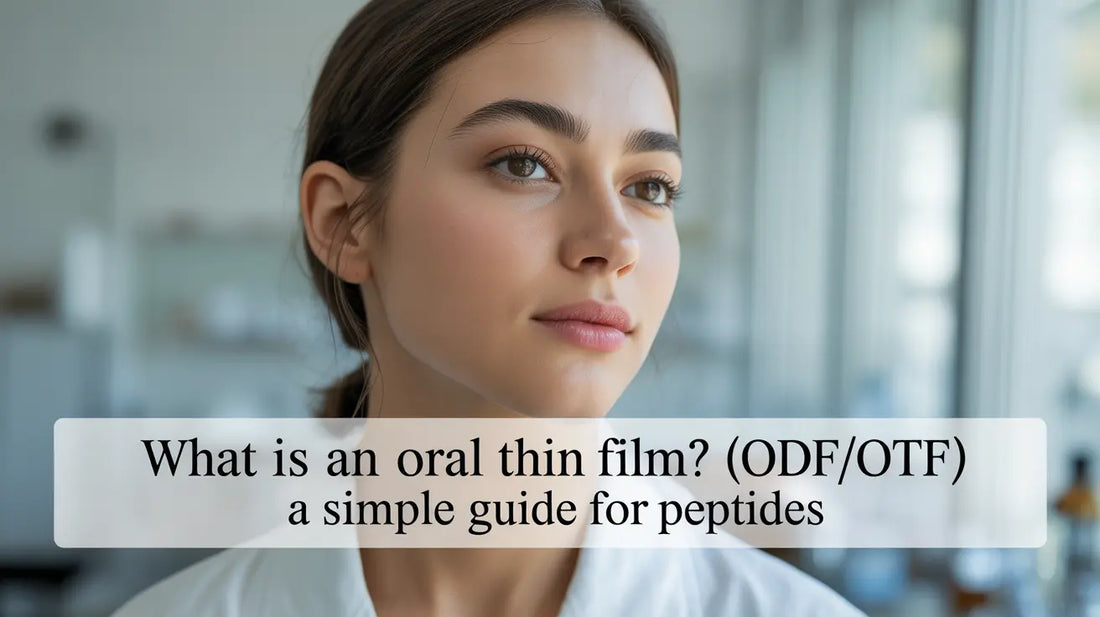
What Is an Oral Thin Film? (ODF/OTF) A Simple Guide for Peptides
Share
An oral thin film (OTF), also called an orodispersible film (ODF), oral strip, or buccal strip, is a small, dissolvable film that delivers active ingredients directly through the tissues of the mouth. For peptides like BPC-157 or TB-500, OTFs are an innovative way to avoid injections while still achieving effective absorption.
In this article, you’ll learn:
- What oral thin films are and how they work.
- Why OTFs are different from capsules and tablets.
- The benefits and challenges of using OTFs for peptides.
- How OTFs compare with other peptide delivery methods.
What Exactly Is an Oral Thin Film?
Let’s start with a clear definition of OTFs in simple terms.
Oral thin films are ultra-thin, flexible strips made from safe, dissolvable polymers. When placed on the tongue, under the tongue, or against the cheek, they rapidly dissolve and release the active ingredient. This makes them an attractive needle-free and user-friendly option for delivering peptides.
How Oral Thin Films Work
Here’s the basic mechanism behind OTF absorption, explained in more detail for better understanding.
- Placement: The strip is placed under the tongue (sublingual) or inside the cheek (buccal). This ensures that the film comes into close contact with mucosal tissues that are rich in blood vessels.
- Dissolution: Saliva quickly breaks down the thin film, usually within seconds to a couple of minutes depending on the formulation and thickness. The polymers used are designed to dissolve smoothly without leaving residue.
- Absorption: As the film dissolves, the peptide is released and passes through the mucosal lining into the bloodstream. This process allows for more consistent uptake compared to traditional oral capsules.
- Bypass digestion: Unlike capsules, OTFs avoid much of the breakdown in the gut and first-pass metabolism in the liver. This helps preserve the integrity of delicate peptides.
- Onset of action: Because the drug enters directly through the oral mucosa, effects may begin faster than conventional oral forms, often within 15–45 minutes.
- Patient experience: The simplicity of letting a film dissolve naturally makes this form attractive for those who want convenience and less stress compared to needles or swallowing large pills.
Key Benefits of Oral Thin Films for Peptides
Here are the main reasons why OTFs are gaining attention in peptide therapy, with additional context to show their practical value.
- Needle-free dosing: Perfect for users who dislike or avoid injections, eliminating the pain, anxiety, and risk of improper technique that can come with needles.
- Rapid absorption: Works faster than swallowing a capsule, with noticeable onset often in under an hour, which is valuable for people seeking timely benefits.
- Convenient & portable: Easy to carry and use discreetly, making them suitable for work, travel, or training environments where injections or pills may be less practical.
- Improved compliance: Simpler daily routine means fewer missed doses, which is especially important for long-term therapies where consistency leads to better outcomes.
- Potentially higher bioavailability: More peptide reaches the bloodstream compared to traditional oral capsules, and ongoing innovations in formulation continue to push bioavailability higher.
- User-friendly format: Thin films are small, tasteless or lightly flavored, and dissolve quickly, giving a smoother overall experience than swallowing tablets.
- Better safety profile: No injection-site issues like swelling or infection, and lower systemic stress compared to oral capsules that must pass through the liver.
Challenges and Limitations
It’s also important to consider some drawbacks with OTFs, since no delivery system is without its limits and users should understand the potential downsides.
- Taste issues: Some peptides have a bitter profile, which can make the experience less pleasant, though flavoring agents may help mask it.
- Irritation risk: Sensitive users may feel mild mouth irritation, dryness, or tingling, especially if using strips daily or keeping them in the same spot repeatedly.
- Formulation limits: Not all peptides can be loaded into strips at effective doses yet. High-dose therapies may be impractical in this format because films have limited space to carry active ingredients.
- Less research: Compared to injections, fewer large-scale studies exist on peptide OTFs. This means real-world feedback and smaller pilot studies often guide decisions rather than extensive clinical trial data.
- Stability concerns: OTFs must be carefully packaged to avoid moisture or heat damage, as thin films are more delicate than capsules or vials.
- Variable absorption: Bioavailability can vary between individuals due to saliva flow, placement technique, or differences in oral mucosa thickness.
Oral Thin Films vs Other Peptide Delivery Methods
To see the bigger picture, here’s how OTFs compare to other forms.
| Form | Absorption Speed | Ease of Use | Bioavailability | Main Advantage |
|---|---|---|---|---|
| Oral Thin Film | 15–45 min | Very easy | Moderate–High | Needle-free, fast absorption |
| Injection | 30–60 min | Difficult | High (~100%) | Fastest, most precise dosing |
| Capsule/Tablet | 1–2 hrs | Easy | Low–Moderate | Familiar, simple dosing |
| Nasal Spray | 10–30 min | Easy | Moderate (varies) | Quick and non-invasive |
Key takeaway: Oral thin films provide a balance — faster and more effective than capsules, but much easier and safer than injections.
Are Oral Thin Films the Future of Peptide Therapy?
Here’s what the current trend suggests.
With advances in formulation technology, OTFs are becoming more reliable for peptides like BPC-157 and TB-500. They combine convenience, compliance, and effectiveness, making them an appealing choice for both beginners and long-term users. As awareness grows, OTFs could become the default form for many peptide therapies.
